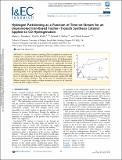Hydrogen partitioning as a function of time-on-stream for an unpromoted iron-based Fischer-Tropsch synthesis catalyst applied to CO hydrogenation
Abstract
Inelastic neutron scattering (INS) is employed to examine the evolution of a promoter-free iron-based Fischer-Tropsch synthesis catalyst (∼10 g catalyst charge) that is exposed to ambient pressure CO hydrogenation at 623 K for up to 10 days time-on-stream (T-o-S). The longer reaction time is selected to better understand how the formation of a previously described hydrocarbonaceous overlayer corresponds to the catalyst conditioning process. Although the onset of pseudo steady-state reactor performance is observed at approximately 9 h T-o-S, INS establishes that the intensity of the C-H stretching mode of the sp3-hybridized component of the hydrocarbonaceous overlayer saturates at about 24 h T-o-S, while the corresponding intensity of the C-H stretching mode of the sp2-hybridized component requires 100-200 h T-o-S to achieve saturation. This novel series of measurements reveal different aspects of the complex catalyst evolutionary process to be indirectly connected with catalytic turnover.
Citation
Davidson , A L , Webb , P B , Parker , S F & Lennon , D 2020 , ' Hydrogen partitioning as a function of time-on-stream for an unpromoted iron-based Fischer-Tropsch synthesis catalyst applied to CO hydrogenation ' , Industrial and Engineering Chemistry Research , vol. 59 , no. 1 , pp. 52-60 . https://doi.org/10.1021/acs.iecr.9b04636
Publication
Industrial and Engineering Chemistry Research
Status
Peer reviewed
ISSN
0888-5885Type
Journal article
Description
Sasol Ltd., the EPSRC (award reference EP/P505534/1), and the University of Glasgow are thanked for the provision of a postgraduate studentship (ALD). The STFC Rutherford Appleton Laboratory is thanked for access to neutron beam facilities. The Royal Society is thanked for the provision of an Industry Fellowship (PBW).Collections
Items in the St Andrews Research Repository are protected by copyright, with all rights reserved, unless otherwise indicated.

